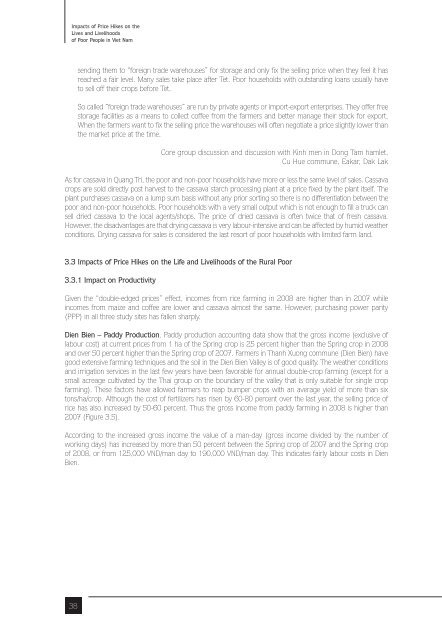Untitled - Oxfam Blogs
Untitled - Oxfam Blogs
Untitled - Oxfam Blogs
You also want an ePaper? Increase the reach of your titles
YUMPU automatically turns print PDFs into web optimized ePapers that Google loves.
Impacts of Price Hikes on the<br />
Lives and Livelihoods<br />
of Poor People in Viet Nam<br />
sending them to “foreign trade warehouses” for storage and only fix the selling price when they feel it has<br />
reached a fair level. Many sales take place after Tet. Poor households with outstanding loans usually have<br />
to sell off their crops before Tet.<br />
So called “foreign trade warehouses” are run by private agents or import-export enterprises. They offer free<br />
storage facilities as a means to collect coffee from the farmers and better manage their stock for export.<br />
When the farmers want to fix the selling price the warehouses will often negotiate a price slightly lower than<br />
the market price at the time.<br />
Core group discussion and discussion with Kinh men in Dong Tam hamlet,<br />
Cu Hue commune, Eakar, Dak Lak<br />
As for cassava in Quang Tri, the poor and non-poor households have more or less the same level of sales. Cassava<br />
crops are sold directly post harvest to the cassava starch processing plant at a price fixed by the plant itself. The<br />
plant purchases cassava on a lump sum basis without any prior sorting so there is no differentiation between the<br />
poor and non-poor households. Poor households with a very small output which is not enough to fill a truck can<br />
sell dried cassava to the local agents/shops. The price of dried cassava is often twice that of fresh cassava.<br />
However, the disadvantages are that drying cassava is very labour-intensive and can be affected by humid weather<br />
conditions. Drying cassava for sales is considered the last resort of poor households with limited farm land.<br />
3.3 Impacts of Price Hikes on the Life and Livelihoods of the Rural Poor<br />
3.3.1 Impact on Productivity<br />
Given the “double-edged prices” effect, incomes from rice farming in 2008 are higher than in 2007 while<br />
incomes from maize and coffee are lower and cassava almost the same. However, purchasing power parity<br />
(PPP) in all three study sites has fallen sharply.<br />
Dien Bien – Paddy Production. Paddy production accounting data show that the gross income (exclusive of<br />
labour cost) at current prices from 1 ha of the Spring crop is 25 percent higher than the Spring crop in 2008<br />
and over 50 percent higher than the Spring crop of 2007. Farmers in Thanh Xuong commune (Dien Bien) have<br />
good extensive farming techniques and the soil in the Dien Bien Valley is of good quality. The weather conditions<br />
and irrigation services in the last few years have been favorable for annual double-crop farming (except for a<br />
small acreage cultivated by the Thai group on the boundary of the valley that is only suitable for single crop<br />
farming). These factors have allowed farmers to reap bumper crops with an average yield of more than six<br />
tons/ha/crop. Although the cost of fertilizers has risen by 60-80 percent over the last year, the selling price of<br />
rice has also increased by 50-60 percent. Thus the gross income from paddy farming in 2008 is higher than<br />
2007 (Figure 3.5).<br />
According to the increased gross income the value of a man-day (gross income divided by the number of<br />
working days) has increased by more than 50 percent between the Spring crop of 2007 and the Spring crop<br />
of 2008, or from 125,000 VND/man day to 190,000 VND/man day. This indicates fairly labour costs in Dien<br />
Bien.<br />
38

















